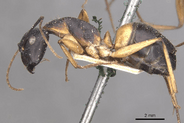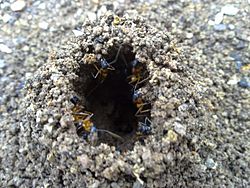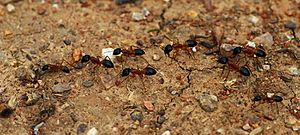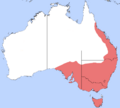Banded sugar ant facts for kids
Quick facts for kids Banded sugar ant |
|
|---|---|
 |
|
| Worker with cocoon | |
| Scientific classification | |
| Genus: |
Camponotus
|
| Species: |
consobrinus
|
 |
|
| Distribution of the banded sugar ant | |
The banded sugar ant (Camponotus consobrinus) is also known simply as the sugar ant. This ant species lives in Australia. It belongs to a group of ants called Camponotus ants. A German scientist named Wilhelm Ferdinand Erichson first described this ant in 1842. Its common name comes from two things: these ants love sugar and sweet foods, and they have a special orange-brown band around their body (called a gaster).
Banded sugar ants are quite large and come in different forms. There are two main types of workers: major workers (sometimes called soldiers) and minor workers. These workers are usually about 5 to 15 millimetres (0.2 to 0.6 in) long. Queen ants are even bigger! These ants are mostly active at night. They prefer places that are not too dry, like forests and woodlands. You can also find them in cities, where they sometimes become a nuisance in homes. Banded sugar ants eat sweet liquids called honeydew, which they collect from tiny insects like aphids. They also compete with another ant called the meat ant. Sometimes, they even steal food or block each other's nests! Banded sugar ant workers hunt insects and kill them by spraying a chemical called formic acid. Other animals like echidnas and birds eat banded sugar ants. Long ago, Indigenous Australians even ate the eggs of these ants.
Contents
What Do Banded Sugar Ants Look Like?
Banded sugar ants are large, measuring from 5 to 15 millimetres (0.2 to 0.6 in) in length. In a colony, you'll find two types of workers: minor workers and major workers. Minor workers are smaller and thinner, while major workers (soldiers) are larger and stronger. Both types of workers have strong mandibles (jaws). The queen ants are the biggest ants in the colony.
Female banded sugar ants are easy to spot. They have a black head, an orange middle body (called a thorax), and that special orange-brown band around their back section (the gaster). Male ants are completely black. The sides of their bodies and legs are a rusty color. The base of their antennae and their mandibles are black.
There's a similar ant called the black-headed sugar ant (Camponotus nigriceps). You might confuse them! However, black-headed sugar ants are usually lighter in color, and they don't have the orange-brown band on their gaster.
Where Do Banded Sugar Ants Live?
The banded sugar ant lives in many parts of Australia, especially in the southeast. You can find them along the northeast coast of Queensland, all through New South Wales, the Australian Capital Territory, Victoria, and Tasmania. In South Australia, they are common in cities like Adelaide.
These ants live in many different places, including:
- City areas
- Eucalypt forests
- Woodlands
- Grasslands
- Heaths
They prefer places that are not too dry. In very dry parts of Australia, you usually won't find them. Banded sugar ants have been found in places from 170 to 853 metres (558 to 2,800 ft) above sea level.
Their nests can be in many different spots. They might build nests in:
- Holes in wood
- Plant roots
- Tree branches
- Between rocks
- In the soil
- Under paving stones
Sometimes, they build small, funnel-shaped mounds that are less than 20 cm (8 in) wide. But in natural areas, their nest entrance is usually just a smooth, vertical hole about 15 to 17 millimetres (0.59 to 0.67 in) wide. The rooms inside their nests are like shafts, with floors about 20 to 30 millimetres (0.8 to 1.2 in) long and arched roofs about 10 millimetres (0.4 in) high. They have even been known to take over old nests of meat ants!
How Do Banded Sugar Ants Behave?
Banded sugar ants are the main type of ant active at night in their areas. Workers are often seen at dusk, searching for food on trails or on Casuarina and Eucalyptus trees. They do forage during the day too, but they are much more active at night. They are also busier during warmer times of the year, especially summer.
When a banded sugar ant finds a good food source, it uses different ways to tell other ants where to go. They might:
- Carry another worker to the food.
- Do "tandem running" where one ant leads another.
- Leave a special scent trail (a pheromone trail) for others to follow.
Banded sugar ants sometimes attack the nests of other ant species. They grab their enemies with their mandibles and spray formic acid to kill them. When they are looking for food, they use visual cues like landmarks to find their way around. If they feel threatened, a banded sugar ant will lift its abdomen and use its big jaws to scare off an attacker. If that doesn't work, it can spray formic acid from its abdomen, which can hurt predators.
Meat ants are a common rival of banded sugar ants. Meat ants have been seen blocking the entrances of banded sugar ant nests with small stones and dirt. This stops the sugar ants from leaving their nest in the morning. But banded sugar ants fight back! They block the meat ants' nests with debris, a behavior called "nest-plugging." If a meat ant nest gets too much shade, banded sugar ants might even invade and take it over. The meat ants then have to move to a new nest.
Some birds, like starlings, have been seen rubbing banded sugar ants on their feathers. This behavior is called anting.
What Do Banded Sugar Ants Eat?
Banded sugar ants eat many different things, making them omnivores. They love sweet foods. They often "farm" plant-eating insects like aphids. They collect the sweet liquid called honeydew that aphids produce from their rear ends. This is a helpful relationship for both: the ants protect the aphids from danger, and the aphids give the ants a nutritious liquid. Banded sugar ants also look after the young (larvae) of a butterfly called the southern purple azure butterfly.
They visit the flowers of Eucalyptus globulus trees and can help pollinate them. At night, in cities, they might search for other small creatures like termites or ticks under lights. They are also known to "steal" honeydew from insects that meat ants feed on during the day. Banded sugar ants and meat ants often build nests close to each other. When they forage in the same areas, they tend to have shorter feeding times because they get in each other's way.
Ant Life Cycle
Like all ants, banded sugar ants start as eggs. If an egg is fertilized, it will become a female ant (a worker or a queen). If it's not fertilized, it will become a male ant. They go through complete metamorphosis, which means they change a lot as they grow. They pass through a larva stage and a pupa stage before becoming adult ants.
Most banded sugar ant colonies have only one queen (this is called monogynous). But some colonies have been found with multiple queens! In these colonies, the queens get along and their young mix freely. Queens can live for seven years or even longer.
Not much is known about their nuptial flight (when queens and males fly to mate). However, young queens and males (called alates) have been seen mating in South Australia in January and in Southeast Queensland in December. This suggests they mate in mid-summer. The best conditions for their mating flights are warm afternoons, when temperatures are around 20–25 °C (68–77 °F).
Banded Sugar Ants and Humans
Banded sugar ants are sometimes considered a household pest. They can sometimes chew on wood furniture or fittings inside houses. If a nest is found, people sometimes use chemicals to remove it.
These ants are not dangerous to humans. They cannot sting. They can only spray formic acid, which can be irritating to human skin. However, the larger soldier ants can give a painful bite with their strong jaws. As mentioned before, the eggs of these ants were eaten by Indigenous Australians.
Images for kids
See also
 In Spanish: Camponotus consobrinus para niños
In Spanish: Camponotus consobrinus para niños













